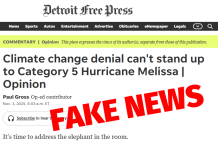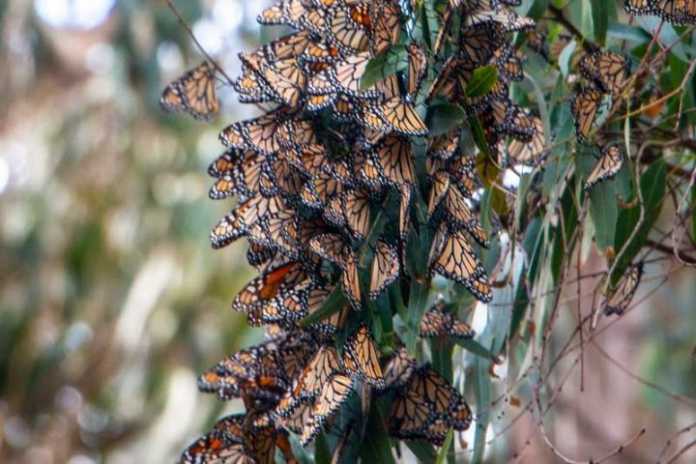Guest essay by Jim Steele
Last week the Guardian proclaimed Butterfly Numbers Plummeting in US West as Climate Crisis Takes Toll. Numerous media outlets flooded the internet with similar versions in response to the research article Fewer Butterflies Seen by Community Scientists Across the Warming and Drying Landscapes of The American West by lead author Dr. Matt Forister. For the factors examined, their research found climate change had the greatest statistical effect associated with changing butterfly populations. Warmer summer temperatures however had a positive effect, while warmer autumn temperatures had a negative effect. Of course, in an age where chicken little catastrophes sell, only warming fall temperatures and butterfly extinctions could promote a profitable climate crisis. Worse, the public was misled to assume “all” western butterflies were declining.
For example, a University of Arizona press release (home of Forister’s co-author) stated, “Western butterfly populations are declining at an estimated rate of 1.6% per year,….The report looks at more than 450 butterfly species.” However, the researchers only stated their databases “encompassed more than 450 species”. In reality their analyses addressed just 289 species of which only 182 or 40% of the 450 species exhibited declining populations. Another 107 species were stable or increasing, and 161 lacked sufficient data for analysis.
It’s expected that during any given decade various populations of a butterfly species will randomly increase in one area but decrease in another, but with no overall declines as recently reported for USA insects. So correctly, Forister et al. asked if a species’ population trend was restricted to a local area or widespread. To answer that they examined 3 independent datasets. The North American Butterfly Association (NABA) supplied their once‑a‑year butterfly counts, typically held around July 4th, of which only 72 different sites had the required 10+ years of data (average was 21 years) with which to determine a species’ abundance trend. A second data set came from Dr. Art Shapiro’s northern California bi-weekly surveys but covered only 10 sites from the San Francisco Bay area to the Sierra Nevada crest at Donner Pass. A third database used iNaturalist’s citizen science data that only provided flashy optics suggesting widespread coverage. Although iNaturalist is a great application that easily connects laypeople with experts for accurate identifications and determines the presence of a species in a given locale, it doesn’t provide trustworthy trend data.
To argue for widespread declines, a species had to be declining in at least two of their three datasets. Comparing trends in the NABA & Shapiro datasets, only 104 species exhibited declines in both. In other words, only 23% of the ballyhooed 450 species showed a possible widespread decline. However, when interviewed by the Washington Post for the article Butterflies Are Vanishing Out West. Scientists Say Climate Change is to Blame, Forister contrarily stated, “The influence of climate change is driving those declines, which makes sense because they’re so widespread”
Despite the real number of examined species, National Geographic still trumpeted 450 Butterfly Species Rapidly Declining Due to Warmer Autumns In The Western U.S. while shamefully ignoring the positive summer warming. Indeed Forister had reported, “locations that have been warming in the fall months have seen fewer butterflies over time”, adding an unsupported hypothesis that “fall warming likely induces physiological stress on active and diapausing stages, reduces host plant vigor, or extends activity periods for natural enemies.” But most butterfly species are no longer flying or laying eggs or feeding during the autumn. Instead, they have snuggled into relative safety from environmental changes to overwinter until the next flush of new springtime vegetation.
The larvae (caterpillars) of some declining species feed on grasses (i.e. Eufala Skipper and Sachem skipper), or herbs (i.e. Cabbage White or Sara Orange-Tip). But most grasses and herbs are dead or dormant by the end of summer. Other larvae of declining species feed on the young leaves or needles produced by trees in the spring (like Propertius duskywing or Western pine elfin). Autumn warmth has no effect on the “vigor” of dead or dormant food plants. Autumn temperatures are simply not critically important. Natural enemies like parasitic wasps typically evolved similar sensitivities to the same environmental cues as their caterpillar hosts and insect eating birds begin migrating south in August. Claiming global warming somehow selectively hurts butterflies but helps their enemies is a totally unsupported claim hurled far too often by those fabricating a climate crisis.
Disturbingly, Forister et al. simultaneously downplayed known benefits of summer warming, suggesting it only increased ‘butterfly visibility’ stating, “warming in the summer influences adult activity times directly and hence increases the probability of detection”. But to power their flight, butterflies sunbathe to raise their body temperature above ambient air temperature. Increased activity is needed for mating and finding host plants. Greater summer warmth also enables faster larval growth, which in some species enables an increased number of generations each year enabling larger summer populations (i.e. Monarchs). In other species like Edith’s checkerspot the caterpillars seek hotter surfaces to grow fast enough each summer and reach a required size allowing overwinter survival. Warmer summers benefit many species in many ways.
To my knowledge not one media outlet reported the summer benefits or the most telling conclusion of Forister et al. “Although our analyses point to warming fall temperatures as an important factor in insect declines, we acknowledge the multifaceted nature of the problem and how muchremains to be understood about climate change interacting with habitat loss anddegradation.”
If Forister et al. were truly trying to decipher the causes for observed butterfly declines, they should have at least adhered to the most basic scientific principle of controlling for known confounding factors. To blame climate change, confounding effects must be removed. But they were not. Thus, declining trends could be completely caused by insecticides and land use. And Forister was well aware of such important factors.
In a 2010 paper co-authored with Dr. Shapiro he found, “most severe reductions at the lowest elevations, where habitat destruction is greatest.” In a 2014 paper Forister concluded “Patterns of land use contributed to declines in species richness, but the net effect of a changing climate on butterfly richness was more difficult to discern.” In his 2016 paper he modelled negative effects of neonicotinoid insecticides. Listed as Forister’s 37th most declining species, the media highlighted the recent 99% decline of western Monarch butterflies. Yet the Monarch’s big killers are also land use change and herbicides, not climate change.

In the 1970s scientists discovered virtually all monarchs breeding east of the Rocky Mountains migrate to extremely small patches of high mountain forests in central Mexico. When that critical wintering habitat was logged, it opened the forest canopies removing its insulating effects. In January 2002, a storm brought cold rains followed by clear skies. Without the clouds’ greenhouse effect, or an insulating forest canopy, temperatures plummeted to 23°F (- 4°C). Millions of damp butterflies froze in place. Many millions more fell creating an eerie carpet of dead and dying butterflies several inches deep. Distraught researchers calculated 500 million butterflies died that winter, wiping out 80% of the entire eastern population. Similar cold events happened in 2004, 2010 and 2016.
In contrast, monarchs breeding west of the Rockies winter along the California coast to Baja where the ocean moderates temperatures and prevents freezing. Nonetheless those wintering populations also plummeted by 81% by 2014. Interestingly, tagging studies and genetics suggest California and Mexican wintering populations intermingle. Although it’s not clear if one wintering population contributes to the other, their abundance has fluctuated very similarly. In addition, a 1991 statewide study implicated land use as 38 overwintering sites in California were destroyed.
Herbicides severely reduced the monarch’s food plants, milkweeds. Adapted to colonizing open disturbed landscapes, milkweed species began invading the fertilized ground between rows of crops. As 1900s monarch populations boomed, farmers’ crops suffered. Milkweed competition reduced harvests of wheat and sorghum by 20% and most states declared milkweed a noxious weed. Attempts to eradicate milkweed by tilling only stimulated underground roots promoting more milkweed. The 1970s discovery that the herbicide glyphosate (i.e. Roundup) killed the whole plant, turned the tide against milkweed. When genetically modified herbicide‑resistant soybean and corn crops were developed in 1996, herbicide use dramatically increased, furthering the milkweeds rapid decline. That loss of milkweed now hinders monarch recovery. For monarch lovers, our best safeguard is planting more milkweed in our gardens. Likewise, we can plant butterfly friendly gardens for all species. On the bright side of climate change, warming could allow an added monarch generation.
Jim Steele is Director emeritus of San Francisco State’s Sierra Nevada Field Campus, authored Landscapes and Cycles: An Environmentalist’s Journey to Climate Skepticism and a member of the CO2 Coalition























The alarmists are beginning to panic. What’s next? Migrating cockroaches?
February had record low temperature, in line with the reduction of solar activity. But it takes awhile for average cloud cover to have an effect. It’s likely that Svensmark’s theory together with Easterbrook’s 800,000 years of data will soon take over.